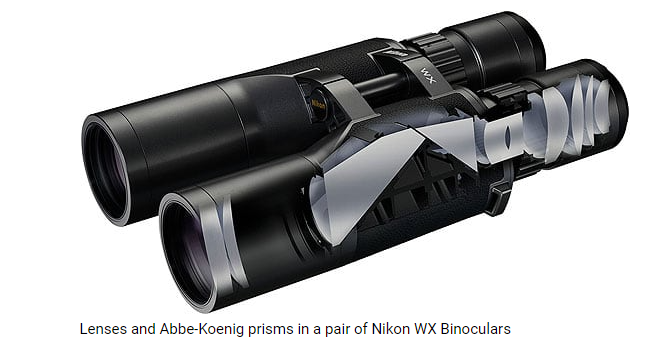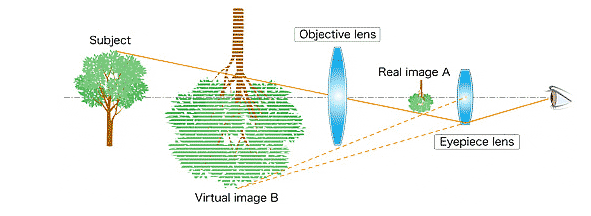In this comprehensive guide, I will go over the science behind how the optics in a pair of binoculars are able to collect light and then present you with a magnified image of the view in front of you. In future articles, I also plan to go over the main mechanics behind how the focus and eye-cup mechanisms work and the range of different options available.

At it's simplest form, a set of binoculars is essentially made up of two telescopes placed side-by-side. So to start with and to make things a little simpler, let us cut our binocular in half and first learn how a telescope works and then we will put them back together at the end:

AB
6x, 7x, 8, 10x, or more.
So a magnification factor of 8, for example, will produce a virtual image that looks 8 times larger than the subject.
Upside-down Image
However, what you will notice when looking through it is that the image that you see will be turned upside-down and mirrored. This is because a convex lens causes the light to cross over as it converges.
In fact you can very easily demonstrate this if you hold a magnifying glass out at about arms length and look at some distant objects through it. You will see that the image will be upside-down and reverse mirrored.
For looking at distant stars, this is not really a problem and indeed many astronomy telescopes produce a non-rectified image, but for terrestrial uses, this is a problem. Luckily there are a few solutions:

Used in telescopes invented Galileo Galilei in the 17th Century, Galilean Optics use a convex objective lens in the normal way, but change this to a concave lens system for the eyepiece.
Whilst a standard mirror is perfect for looking at yourself in the morning, in a binocular it would be no good if the light was simply reflected 180 degree and back to where it came from as you would then never be able to see the image.
This problem was first solved by using a pair of Porro prisms. Named after the Italian inventor Ignazio Porro, a single Porro prism, like a mirror also reflects light 180 degree and back in the direction it came from, but it does it parallel to the incident light and not directly along the same path.
So this really helps because it allows you to place two of these Porro prisms at right angles to each other, which in turn means you can then reflect the light so that it not only re-orients the inverted image but also effectively allows it to continue in the same direction and towards the eyepieces.
Two of them, the Abbe-Koenig prism and the Schmidt-Pechan prism are types of roof prisms that are now commonly used in binoculars.
Of these, the Schmidt-Pechan prism is most common because it allows manufacturers to produce a more compact, slimmer binocular with the eyepieces in-line with the objectives. The downside is that they require a number of special coatings to achieve total internal reflection and eliminate a phenomenon known as phase shifting.




